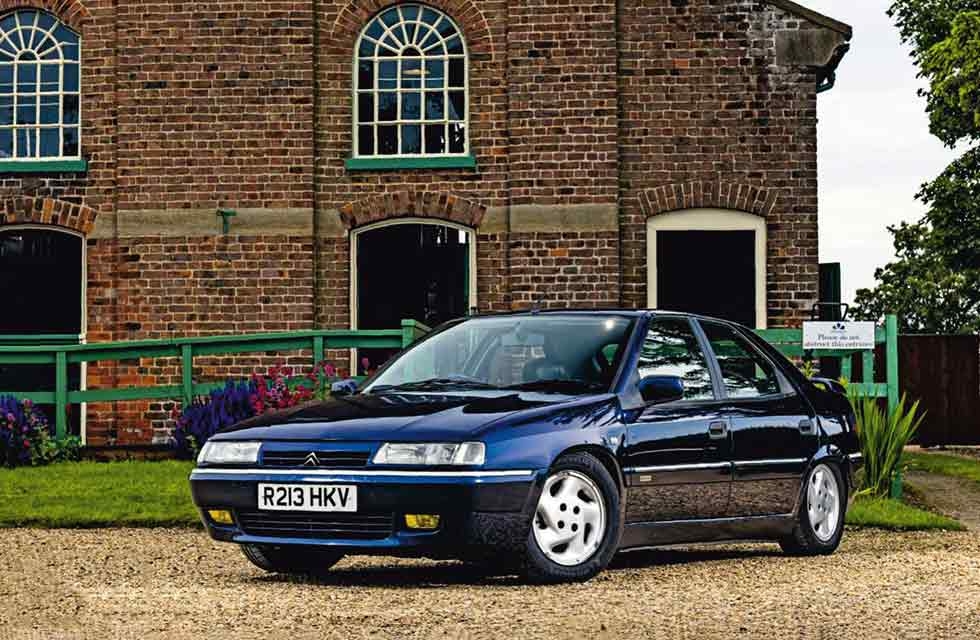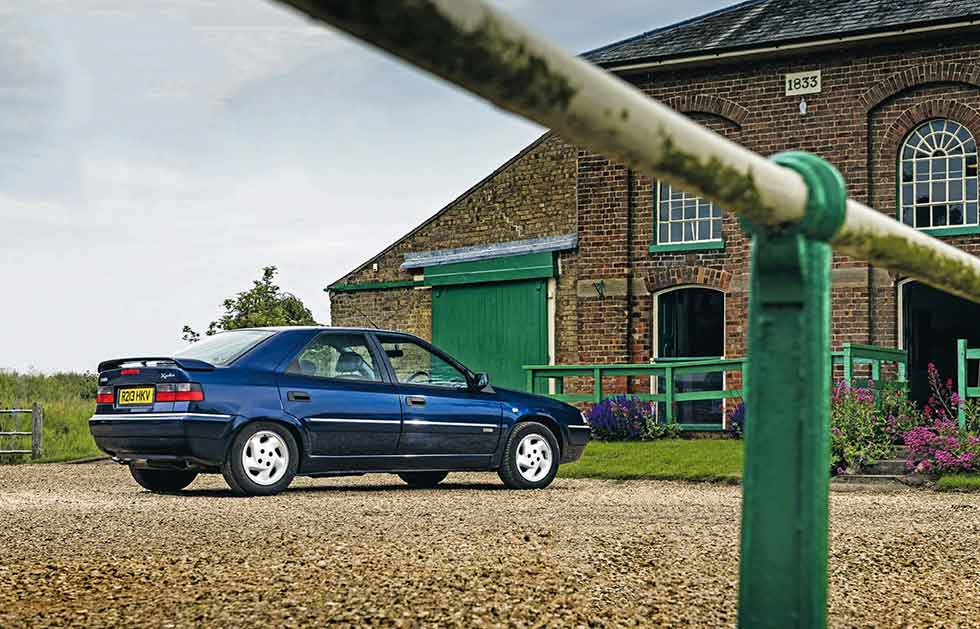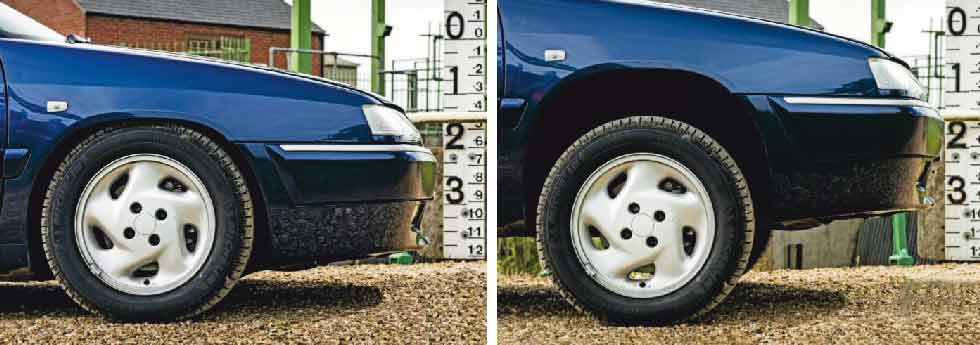
Endangered species nearly gone, not forgotten. Outwardly, the Citroën Xantia Activa looks like a leftfield Mondeo rival. To an extent it was – but it also had a party trick that saw it humble supercars. Words Keith Adams. Photography Jordan Butters.
PUMP UP THE VOLUME
Time to save the GT3-slayer Citroën Xantia Activa
ONLY 17 LEFT ENDANGERED SPECIES: CITROËN XANTIA
It’s not often your hear of a Citroën that can beat a Porsche GT3, so the Xantia Activa needs preserving
Who out there has Issue 1 of Modern Classics? If you do, cast your mind back to the cars featured in it. They were a pretty memorable bunch all told. We were tipping the Ford Focus RS and Alfa Romeo 156 GTA as gilt-edged investments at the £8000 that you could have bought one for back then (sigh…), while Nathan was being blown away by the Porsche 928 (S4) he was lucky enough to be group testing in the mag. What you probably won’t remember is that the Citroën Xantia Activa featured in that issue was an under-the-radar car that you really should care about.

Almost five years on and things have changed. The fast Ford and Alfa have skyrocketed beyond what even we predicted for them, while Nathan is even more in love with the 928 now than he ever was. Except it’s business as usual for the Citroën – it’s not so much under the radar, as very much on the endangered list. Back then, there were 27 taxed examples on the road. Now there are just 17, and although interest in them is on the rise, Citroën’s woeful parts supply means that way too many (48) are off the roads, languishing in various states of disrepair.
This needs to change. Because under the skin of this innocuous-looking repmobile resides one of the most sophisticated – and capable – suspension systems ever to make it to the road. Read on to find out why the final few need to be cherished.
When the Citroën Xantia Activa went on sale in the UK at the end of 1995 for a punchy £19,250, the world was a very different place. It was the long-awaited replacement for the well-regarded BX 16 Valve, and unlike that boxy leftfield hot-hatch, this was the smooth sophisticate, very much on trend with what the market demanded at the time, and just what you’d expect from a Citroën.

It was a long way from being the rev-hungry beast its predecessor was, reserving its major talent for the driver and the few cognoscenti who would appreciate its hidden talents. Aside from reprofiled front wings, a prominent rear spoiler and some Activa-specific trim, it didn’t look much different from a stock Xantia VSX.
For the mid-1990s, it looked and felt right – low-key performance was very much the flavour of the moment thanks to crushing insurance premiums for anything that looked even vaguely sporting.
Power was from a turbocharged 2.0-litre eight-valve four-cylinder, developing a modest 148bhp. Performance was hardly earth-shattering either, with an 8.9-second time for the 0-60mph dash and a maximum speed of 134mph all out. So, not only did it look meeker than the Citroen BX, but it was slower, too. There would be a 3.0-litre V6 Xantia with 194bhp, but that was reserved for the luxury versions…
‘UNLIKE THE BX 16V, THIS WAS THE SMOOTH SOPHISTICATE’
But this was a thinking person’s performance car. On looks alone, it would be easy to conclude that the Activa’s main rivals were the Vauxhall Vectra and Ford Mondeo. Wrong.
Although it was trading blows with GM and Ford in showroom appeal, its dynamics transcended the very best sports saloons you could buy at the time. Citroën’s approach to the performance car rulebook was to shred it and start again, developing its computer-controlled hydropneumatic suspension system even further, allowing it to perform feats that nothing else could.

I hear laughing at the back. Yet the Activa trounced the BMW 3 Series E36 and Audi A4 in group test after group test, thanks to its party trick of being able to corner faster than anyone else – and remain composed in the process.
The magic ingredient was Activa. This computer-controlled, near-zero-roll suspension set-up was claimed by Citroën’s advertising to combine roll-free cornering with the super-comfortable ride Citroën was famous for. And you know what, it was right. Having a double chevron on the nose meant it was complex – ten suspension spheres, two hydraulic rams (see right) and three ECUs – but it was nothing if not effective.
Did it deliver? Swedish car magazine Teknikens Värld – the creator of the famous elk test that nearly killed the Mercedes-Benz A-Class at birth – found it was stunningly quick at high-speed emergency avoidance manoeuvres. How quick? A V6 Activa (unavailable here) sped through the coned-off chicane at 85mph – faster than a 2008 911 GT3 RS 997 and 2017 McLaren 675LT.
This freakish result wasn’t a one-off. French car magazine L’Automobile managed to get the Activa up to 0.94g on the skidpad – placing it squarely between the Honda NSX (0.93g) and Toyota Supra (0.95g). On the road, it was sensational – trading blows with the supercar elite on B-roads, while cossetting tired executives in the outside lane.
Against its price rivals of the day, this was the added extra that should have guaranteed office car park kudos for its owner, and huge sales for its maker. But it wasn’t to be. Despite huge critical success following its launch, the opposition proved too strong. The BMW 320i (E36) might have had a slow start to its sales, but by the end of 1995 it was the established leader of the executive car sector by virtue of being great to drive, good value, and possessing the right badge. Despite not being able to see which way a Xantia Activa went on a B-road, the 3 Series outsold the Gallic glider in the UK by a factor of 100. But how does it stand up today, and were buyers right to shy away from the Activa?
First impressions are positive, but hardly exciting. Jumping in, it’s easy to get comfortable – the driving position is spot-on and the forward visibility is excellent. The interior’s a little plasticky in places, but it’s solid and everything works as it should. The leather interior that’s been retrofitted to this one is in good taste and offers one of the most comfortable driver’s seats I’ve encountered this side of an S-Class.
Fire it up after punching in a four-digit PIN into the oh-so period immobiliser keypad, and it’s easy to see why its engine never gets talked about these days. The old-school 8v light-pressure-turbo power unit idles quietly, and once you’re away, acceleration and overall power delivery never feels any more than adequate.
It’s well-isolated, and quiet – revving it merely makes more noise and doesn’t really deliver any real performance benefit. It’s not slow, but neither is it fast – in fact it feels almost diesel-like in how it drives; as such, you’re best off to keep it in the mid-range, relax, minimise your notchy gearchanges and drive along at the pace its makers intended. Leave the frantic haring around to the BMW drivers.
But then the first corner arrives. Turn The wheel, ignore the laughably inert steering and ride the bend. Hang on a minute, what bend? Forget dialling-in pre-determined speeds for corners you might know well on a familiar piece of road – do that, and you’ll feel like you’re barely moving, it feels so effortless and composed. The temptation is to turn around and try again, just a little more quickly – doing so serves up the same result just with more lateral g-force. Corners cease being corners; and after acclimatisation, you’re barrelling through at high speeds, without a care in the world.
Roundabouts are dismissed in a series of left-right flicks of the wrists, as are what could be seen as challenging bends in any other car. Once the realisation of just what this car can do in corners sets in – and how quick it is at doing it – you start to understand what makes this a great, if unconventional, performance car.
This one is riding on the correct Michelins, which benefit from the hugely stiff sidewalls that an Activa needs to perform at its best. Those stiff sidewalls are required in order to maintain those all-important optimal tyre contact patches, and they really are needed. Get the tyre choice wrong, and a hard-driven Activa will conjure up lift-off oversteer like you wouldn’t believe. And because you’ll be going so fast when it happens, you’ll need the skills of Lewis Hamilton to avoid making a mess of it.
Youtube is full of videos of Xantia Activas on track – and there, you’ll see them perform all manner of supercar-humbling tricks. In reality, the novelty of such incredible cornering soon wears off, and you’re back to appreciating the Activa’s comfortable, laid-back character and making effortless, rapid and relaxed progress, just as it should be. Once a Citroën, always a Citroën.
Anonymous looks cloak technical ingenuity. Interior is missing ancestors’ quirkiness. Not sporty, but carries momentum like no other. Sphere today, gone tomorrow? Hope not. All rise: ride height is usefully adjustable. Periodperfect immobiliser pinpad. Is it even French if it doesn’t have yellow fogs? Double chevrons = suspension hocus pocus. 8v four-cyl was sadly mediocre.
The Modern Classics view
In reality, the Activa’s legacy is limited. Citroën ditched this system after being used in only the Xantia, and while there are many modern cars that now feature similar suspension set-ups, none have gone for the (near) zero-roll concept that makes this car so devastatingly effective as a point-to-point sporting machine. So, as such, it’s a technical curiosity, and something of a commercial flop, not helped by the undistinguished engine and the lack of the V6 (and diesel) options that were open to continental Activa buyers.
On top of that, it’s hard to maintain properly, heavy and slow, and styled to blend into the background. But none of those things matter when it comes to our view of the Xantia Activa. Here we have a car that has devilishly effective handling, and near-supercar levels of high-speed composure. It can’t beat the laws of physics – a fact that’s bought into sharp relief if you don’t run it on the correct Michelin tyres – but you’ll think that it can thanks to its ceaseless grip in corners. As party tricks go, that’s a good one, especially as many modern cars have yet to catch up.
Reason enough to ensure the remaining examples are loved and cherished. We’ve seen a modest, but genuine upwards shift in values recently. Back in 2015 when we originally featured this car in Modern Classics, you could still pick up a usable Activa for less than £500. Today your entry point is around £1500, rising to £4000 for a minter. Although we generally hate seeing the prices of the cars we love go up, in this case, it has to be a good thing – if there’s value in it, then more owners will make the effort to run and fix them properly. And ultimately, an important piece of history, like this, should be preserved and enjoyed for the future.
THANKS Pinchbeck Engine museum – Victorian Pumping station wellandidb.org.uk
CITROËN XANTIA ACTIVA
Engine 1998cc, 4-cyl,OHC
Transmission FWD, 5-speed manual
Max Power 148bhp @ 5300rpm
Max Torque 173lb-ft @ 2500rpm
Weight 1410kg
PERFORMANCE
0-60mph 8.9sec
Top speed 132mph
Economy 25mpg
I BOUGHT ONE JAMES HARVEY
‘Having owned a few Activas, it pays to get friendly with your local Citroën specialist. But once you learn the language of hydraulics, you’ll find they’re not as complex or expensive to run as you might’ve feared. Forking out on the correct Michelins is essential – the suspension works them hard in the bends and will quickly destroy cheap rubber. Don’t expect great fuel economy either. Nevertheless, the fastest cornering family car in history can be yours for just £1500.’
ACTIVA SUSPENSION HOW IT WORKS
First things first: the Activa does not have active suspension – it’s a very effective reactive set-up. The Activa system was a development of the Citroën XM’s Hydractive system, which used computer control to stiffen its hydropneumatic suspension in bends and reduce body roll.
The Activa took this principle a step forward by incorporating a pair of additional centrally mounted suspension spheres in the front and rear anti-roll bars. In essence, these spheres act as dampers within the superthick 28mm anti-roll bar, allowing them to twist more easily and therefore behave like a more comfortable 23mm item. However, when cornering, the computer would detect body roll, and would shut off the valves in the central spheres, thus making the anti-roll bars act like 28mm jobs.
In order to stop the Activa leaning over more than 0.5 degrees in corners, a further system would kick in. One of the three suspension ECUs would oversee the pumping of hydraulic fluid into a pair of rams that would further adjust the anti-roll bars’ stiffness. Citroën could have given it a zero-degree roll angle but felt that owners would find this too weird.
As it was, most owners took time to come to terms with the Activa’s flat cornering, and some never did. The resultant high levels of lateral grip and feel-free steering meant that the driver was rarely signalled any clue just how hard the car was working – and quite a few were lost in the early years due to falling off the road at high speed. This, combined with the system’s weight and complexity, meant that the Activa system was abandoned after the Xantia, despite huge investment from its maker.






